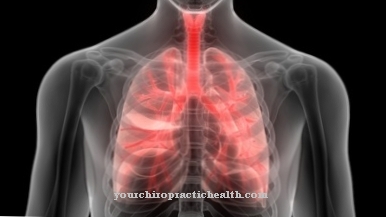The Organogenesis describes the process of development of the organ systems during embryogenesis. In humans, organogenesis begins during the first to second week of the embryo and ends around the 61st day of pregnancy with the onset of fetogenesis.
What is organogenesis

During the organogenesis, the organs develop from the different cotyledons. The cotyledons are tissue structures that are formed during embryogenesis. In humans, a distinction is made between three cotyledons. Different organs arise from the endoderm, mesoderm and ectoderm.
In addition to the process of natural organogenesis, the development of artificial organs or artificial organ parts in the test tube is also referred to as organogenesis.
Function & task
The fastest development of the embryo takes place in the early embryogenesis. This is where the three cotyledons develop, from which the organs then emerge in the course of organogenesis. The digestive tract, liver, pancreas, thyroid, thymus, respiratory tract, urinary bladder and urethra are formed from the endoderm, the inner cotyledon.
Embryonic liver development is particularly interesting. The liver, the central metabolic and detoxification organ of the human body, emerges from a single bud of the endoderm. The mature organ is then created through the gradual increase in tissue. The development of the liver-gallbladder system can be divided into two steps. First, the functional tissue of the liver, gallbladder and biliary tract is developed. The intrahepatic vascular system, i.e. the vascular system within the liver, then develops.
The skin, the nervous system, the sensory organs and the teeth are formed from the ectoderm, the upper germ layer of the embryoblast. The nervous system arises from the neural tube, which in turn forms from the 25th day of development through the union of the two neural folds. In the middle of the sixth week, the formation of the neural tube and thus the creation of the nervous system is complete.
From the mesoderm, the middle germinal layer, bones, skeletal muscles, connective tissue, heart, blood vessels, blood cells, spleen, lymph nodes, lymph vessels, adrenal cortex, kidneys, gonads, the internal genital organs and the smooth muscles of the abdominal organs develop.
The cardiovascular system is the first organ system to start working in the embryo's body. The cardiovascular system is functional from the third week of pregnancy. During the development of the heart, the heart sometimes only consists of an atrium and a chamber. Separation into two heart chambers and two auricles occurs only through a complicated formation of different walls.
The development of the skull of the embryonic head in particular is an extremely complex process. The attachment material for the skull comes from the neural crest, the mesoderm, the two upper pharyngeal arches and the so-called occipital somites.
After the completion of the organogenesis and the end of the embryogenesis, the human form of the unborn child is already clearly recognizable. Gradually, the organs differentiate themselves in the course of fetogenesis and take on their later end function.
Illnesses & ailments
Disturbances in the various stages of organogenesis development can lead to many clinically relevant diseases. Until the onset of fetogenesis, the unborn child is particularly susceptible to external disruptive factors, so that there is a higher risk of miscarriages and deformities of the embryo, especially in the first weeks of pregnancy.
If an incomplete closure of the neural tube occurs during organogenesis, neural tube defects are the result. The malformations can appear differently. The most common neural tube defect is anencephaly. In anencephaly, large parts of the brain, meninges, and skull bones are not fully developed. Anencephaly develops before the 26th day of pregnancy. Live born children with this malformation usually die within a few hours after birth.
Another neural tube malformation is spina bifida. This malformation develops between the 22nd and 28th day of embryogenesis. Spina bifida is also known as "open back" because in children with this disease the vertebral arch or even the membranes of the spinal cord are split in two. Neural tube defects are usually caused by a lack of folic acid.
Numerous malformations can arise during the complicated process of heart development. Most malformations are caused by disturbances during ventricular formation. The ventricular septal defect is such a congenital malformation of the heart. Here the heart septum between the two heart chambers has not closed completely. Depending on the size of the defect, a so-called left-right shunt can occur. Due to the pressure conditions, oxygen-rich blood flows from the left ventricle into the right ventricle. The right ventricle is stressed by the additional blood volume. The heart enlarges with the risk of heart failure later.
Combined malformations can also occur. One such is the Fallot tetralogy. The ventricular septal defect is accompanied by an enlargement of the right heart, a narrowing of the pulmonary artery and a so-called "riding aorta", an anomaly of the aortic arch.
Of course, any other organ can also be affected by disorders in organogenesis.
In particular, the consumption of alcohol and medication increase the risk of the unborn child suffering from a malformation during organogenesis. A well-known example of drugs that promote malformation is certainly thalidomide. The drug was sold as a sleeping aid under the brand name Contergan and in the late 1950s caused numerous serious damage to embryonic development.
Malformations can also be caused by various pathogens. Infections of the mother with rubella, toxoplasmosis and cytomegaly are always a danger for the unborn child. X-rays or radioactive radiation can also cause malformations.












.jpg)



.jpg)










.jpg)
